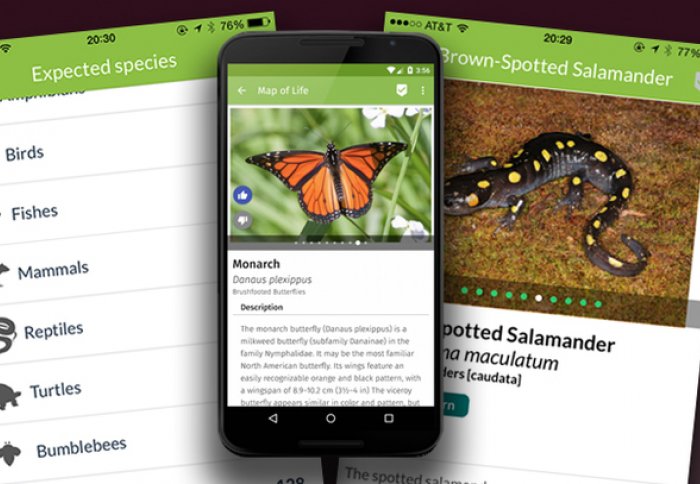

People can check out local wildlife wherever they are in the world with a new app that says what species of animals and plants might be nearby.
The free Map of Life app dispenses with bulky field guides by allowing users to access a vast global database of species and their ranges, based on their location.
This vast information, personalized for where we are, can change the way we identify and learn about the things we see when traveling, hiking in the woods, or stepping in our own back yard.
– Professor Walter Jetz
Building on the Map of Life website, which provides a database of everything from bumblebees to trees, the app tells users in an instant which sets of species are likely to be found in their vicinity. Photos and text help users identify and learn more about what they see. The app also helps users create personal lists of observations and contribute those observations to scientific research and conservation efforts.
“The app puts a significant proportion of our global knowledge about biodiversity in the palm of your hand, and allows you to discover and connect with biodiversity in a place, wherever you are,” said guiding force behind the Map of Life Professor Walter Jetz, a Senior Scientist in the Grand Challenges in Ecosystems and Environment group at Imperial College London and an associate professor at Yale University.
“This vast information, personalized for where we are, can change the way we identify and learn about the things we see when traveling, hiking in the woods, or stepping in our own back yard.”
Instead of sifting through hundreds of pages in a printed field guide, naturalists get a digital guide that is already tailored to their location. With a novel modelling and mapping platform covering tens of thousands of species — everything from mammals and birds to plants, amphibians, reptiles, arthropod groups, and fish — Map of Life presents localised species information via maps, photographs, and detailed information.
Citizen science
Thanks to a recording feature, citizen scientists everywhere can log their bird encounters and dragonfly sightings directly into the app and add to the biodiversity data available to scientists around the world.
“Think of a field guide that continues to improve the more we all use it and add to it. That is the beauty of this mobile application, and its great strength,” said Rob Guralnick, associate curator at the University of Florida and the project’s co-leader. “Built from 100 years of knowledge about where species are found, we hope to accelerate our ability to completely close the many gaps in our biodiversity knowledge.”
Indeed, making it easier and more globally streamlined for citizen scientists to contribute information is one of the key motivations behind creating the app. “The world is changing rapidly and species continue to disappear before we even knew where they occurred, what role they had, and how we could conserve them,” said Professor Jetz, who is involved in several global science initiatives for advancing biodiversity monitoring.
“Too much of our knowledge is limited to too few places and species,” said Professor Jetz. “Helping people everywhere to identify and then record biodiversity carries the potential to hugely extend the geographic and taxonomic reach of measuring the pulse of life.”
Download the Map of Life app, available in six languages for iPhone and Android smartphones.
The National Science Foundation and NASA provided initial support for Map of Life and Google and Senckenberg Gesellschaft für Naturforschung also have supported the project.
Article text (excluding photos or graphics) available under an Attribution-NonCommercial-ShareAlike Creative Commons license.
Photos and graphics subject to third party copyright used with permission or © Imperial College London.
Reporter
Hayley Dunning
Communications Division

Contact details
Tel: +44 (0)20 7594 2412
Email: h.dunning@imperial.ac.uk
Show all stories by this author
Leave a comment
Your comment may be published, displaying your name as you provide it, unless you request otherwise. Your contact details will never be published.




Comments
Comments are loading...